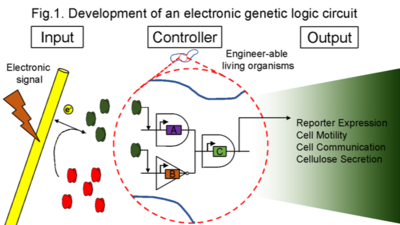Design of Digitally Controlled Bacterial Circuits for Bioenabled Materials
This proposal seeks to understand if bacteria can be designed to perform on demand when inside of a composite material. Bacteria provide a rich source that can be exploited to develop novel and cost-effective adaptive systems that could be superior to traditional materials. Critical to this concept is the ability to control bacterial activity inside materials. To explore this, we will test the hypothesis that if bacteria can be designed to respond to weak currents and survive in UV-activated polymers, then combining those bacteria with nanomaterials in a UV-activated polymer will create a material where the activity of embedded bacteria can be controlled using a computer interface. The hypothesis will be tested by engineering circuits in bacteria that are responsive to oxidation/reduction at the surface of nanowires. We will then use scalable assembly processes to combine bacteria and nanowires in mixed UV-activated polymers to create rigid/soft composite material. Composite bacterial nanowire materials will be interfaced with computer controllers to examine manipulation of bacterial activity in the composite materials.
Project participants:
|
Collaborators:
|
Objectives

The work taking place at Caltech is focused on amplification of redox signal via long-distance, pulsatile cell-cell signaling. Cells embedded in a solid media will have diffusion-limited access to molecules oxidized or reduced at the electrode surface. To achieve uniform response to electrical signals, cells nearer to the electrode must communicate with distant cells. We will augment the redox-sensitive cells with a long-distance signaling circuit, previously studied by our lab, to promote a uniform bacterial reaction to electrical input.
Specific objectives under this task:
- Modify the synthetic SoxR/S regulon such that the output protein is Cmi, the signal synthaseproteinoftheP.aeruginosaCm quorumsensingsystem.
- Demonstrate that the redox-sensitive cells can initiate a traveling pulse of cell-cell signaling activity that moves through cells embedded in a hydrogel to increase the population of cells activated in response to electrical input.
References
None to date
This research is supported by the Institute for Collaborative Biotechnologies through contract W911NF-19-D-0001 from the U.S. Army Research Office. The content of the information on this page does not necessarily reflect the position or the policy of the Government, and no official endorsement should be inferred.
|
|
|